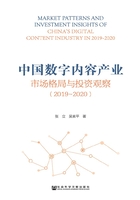
Foreword
The mobile internet technology has changed China’s content industry,which is quickly transforming from traditional radio,TV and publishing to short video online,We Media and live-streaming,the latter becoming the main channel of information production and transmission for the 829 million netizens. As they occupy almost all attention and fragmented time of the users,the digital content industry is arriving on the “express train” of technological innovation. Is Chinese digital content industry able to maintain its vitality?Where is the market going?What opportunities will this fast-changing time bring us and how should we tap them?These are topics we should delve into.
Market Patterns and Investment Insights of China’s Digital Content Industry in 2019-2020 is jointly published by the China Audio-video and Digital Publishing Association and the China Academy of Press and Publication,which updates and refines the definition and classification of the digital content industry on the basis of the Market Patterns and Investment Insights of China’s Digital Content Industry in 2017-2018 and the Market Patterns and Investment Insights of China’s Digital Content Industry in 2015. With close attention paid to ten segmented sectors including online games,animation,online videos,short videos,live-streaming,online music,digital reading,news Apps,online education and knowledge payment,this book enriches and updates data information on the ten sectors,making analysis from the perspectives of market development,payment conversion,competition pattern,dynamics of investment and financing,related policies and traditional mainstream media coverage. It systematically introduces the current development status and characteristics of the digital content industry in China and predicts ten development trends of the industry. It also improves the investment value assessment system over the industry,which comprehensively assesses the investment value of the segmented sectors with 11 level-2 indicators under 7 level-1 indicators in the two categories of internal and external factors,and obtains the investment value ranking of ten segmented sectors,and explores the development differences in ten segmented sectors of the industry from a quantitative perspective. Besides,compared with the previous versions,this book is adjusted structurally into 12 chapters,with ten of them focusing on the ten segmented sectors,the first chapter being introduction and the last chapter making comprehensive analysis and drawing conclusions. The main conclusions are as follows.
Firstly,the digital content industry displays ten development trends. First,the industry remains in scale expansion and short videos present especially impressive performance. Second,the internet traffic dividend has touched the ceiling and content payment may lead a new round of growth. Third,market concentration is considerably improved and with deep layout,Tencent has become an important “head player”. Fourth,investment tends to be conservative and the sinking market becomes a new battlefield for expansion. Fifth,capital pays the most attention to the middle and upper stream of the content industrial chain,and the derivative market remains to be explored. Sixth,as the United States stirs up trade friction,the road for Chinese content companies to expand overseas will be more tortuous. Seventh,the rapid deployment of 5G will bring new opportunities for long video. Eighth,the COVID-19 outbreak may reshape the digital content industry by stimulating online consumption. Ninth,traditional mainstream media are actively getting engaged and short videos market is joined by the national team. Tenth,policy regulation and supervision from the public opinion promote healthy and standardized development of the industry.
Secondly,as revealed by the assessment result on investment value of the digital content industry,sectors of the highest investment value are short videos and online videos,both with a comprehensive assessment of five stars. Sector of comparatively high investment value is digital reading with four stars. Sectors of intermediate investment value are knowledge payment,online games and live streaming with three stars. Sectors of comparatively low investment value are online education,online music and animation with two stars. Sector of the lowest investment value is news Apps,with only one star. Investment dynamics are analyzed as follows:First,short videos steer investment in the digital content industry. Second,attention can be paid to video creation and video service providers for online videos. Third,vertical sector knowledge payment and education service platforms,audiobook investment opportunities should be closely tracked. Fourth,online games and live streaming indicate both opportunities and risks. Policy regulation and risk of negative public opinions need to be duly highlighted. Fifth,caution is required when paying attention to online education and online music,as the competition pattern is not favorable for new investors.
Thirdly,the development characteristics of china digital content industry are summarized as follows:1.Entertainment and experience become important communi-cation factors. 2.China’s digital content industry is diversified business integration of “pan-entertainment,pan-reading,pan-education”. 3.From mass communication to universal express. 4.Short video becomes the mainstream content carrier.
The digital content industry has a wide coverage with various components. This study analyzes the development status of the industry and the segmented sectors from the macro perspective. It also depicts a rough picture of the industrial development. Due to restrictions in research abilities,research energy and access to continuous,unified and authoritative data,this study has its limitations. The conclusions do not sufficiently constitute direct investment reference or basis. This study tries to systematically and truthfully reflect the current development picture of the digital content industry in China by collecting,analyzing and summarizing related materials and data. Corrections of improperness from the industrial insiders are appreciated and we will keep improving the research in the subsequent versions for refined study on the digital content industry in China.